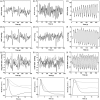Directional sensitivity of dynamic cerebral autoregulation during spontaneous fluctuations in arterial blood pressure at rest
- PMID: 36420777
- PMCID: PMC10063834
- DOI: 10.1177/0271678X221142527
Directional sensitivity of dynamic cerebral autoregulation during spontaneous fluctuations in arterial blood pressure at rest
Abstract
Directional sensitivity, the more efficient response of cerebral autoregulation to increases, compared to decreases, in mean arterial pressure (MAP), has been demonstrated with repeated squat-stand maneuvers (SSM). In 43 healthy subjects (26 male, 23.1 ± 4.2 years old), five min. recordings of cerebral blood velocity (bilateral Doppler ultrasound), MAP (Finometer), end-tidal CO2 (capnograph), and heart rate (ECG) were obtained during sitting (SIT), standing (STA) and SSM. A new analytical procedure, based on autoregressive-moving average models, allowed distinct estimates of the autoregulation index (ARI) by separating the MAP signal into its positive (MAP+D) and negative (MAP-D) derivatives. ARI+D was higher than ARI-D (p < 0.0001), SIT: 5.61 ± 1.58 vs 4.31 ± 2.16; STA: 5.70 ± 1.24 vs 4.63 ± 1.92; SSM: 4.70 ± 1.11 vs 3.31 ± 1.53, but the difference ARI+D-ARI-D was not influenced by the condition. A bootstrap procedure determined the critical number of subjects needed to identify a significant difference between ARI+D and ARI-D, corresponding to 24, 37 and 38 subjects, respectively, for SSM, STA and SIT. Further investigations are needed on the influences of sex, aging and other phenotypical characteristics on the phenomenon of directional sensitivity of dynamic autoregulation.
Keywords: Cerebral autoregulation; cerebral blood flow; multivariate modelling; posture; squat-stand maneuver.
Conflict of interest statement
The author(s) declared no potential conflicts of interest with respect to the research, authorship, and/or publication of this article.
Figures





References
-
- Lassen NA. Cerebral blood flow and oxygen consumption in man. Physiol Rev 1959; 39: 183–238. - PubMed
-
- Heistad D, Marcus M, Busija D, et al.. Protective effects of sympathetic nerves in the cerebral circulation. In: Heistad DD (ed.) Cerebral blood flow: effects of nerves and neurotransmitters. Amsterdam: Elsevier North Holland, 1982, pp.267–273.
-
- Cassaglia PA, Griffiths RI, Walker AM. Sympathetic nerve activity in the superior cervical ganglia increases in response to imposed increases in arterial pressure. Am J Physiol Regul Integr Comp Physiol 2008; 294: R1255–R1261. - PubMed
-
- Aaslid R, Lindegaard KF, Sorteberg W, et al.. Cerebral autoregulation dynamics in humans. Stroke 1989; 20: 45–52. - PubMed
MeSH terms
LinkOut - more resources
Full Text Sources

